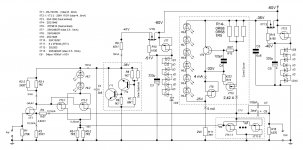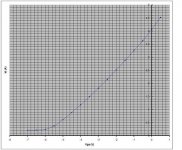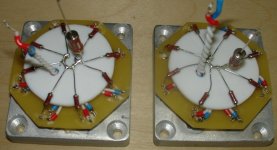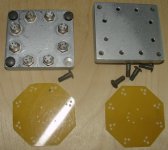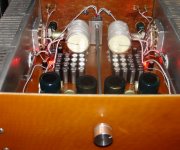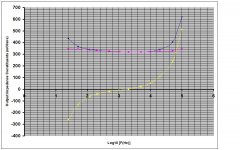I just have assembled a prototype of this amp, and the first listening, before the burning-in procedure, has made me happy. The sound is very-very life-like. Input volume control potentiometer is ALPS 10K (plan to change to DACT). Although I realize that jFET based schematics is rather individual, need specific adjustments, but the final result justifies all the efforts.
Apart of this, I was curious about jFET output stage, is there any listenable effect from its implementation.
For achieving reasonable power, I have assembled a cluster-transistor from 8 pcs of paralleled RF power jFETS KP903A. I enclose the Id vs Vgs curve for this cluster transistor.
In this schematics, an optimum idle current appeared to be 2,4 A.
Since total transconductance is still less than 1S, I had to use some NFB, current NFB via R4, R3 resistors. All measures have been taken for assuring small length of NFB path, and the R4 is non-inductive type for RF applications.
Voltage at the source of VT11 was adjusted by selecting R2-2. Thermal stability of this voltage is good. The schematics shown is “as build”, it is absolutely stable and gives good square wave without any additional correction capacitors.
Now the amp is burning-in, I’ll post some measured characteristics later on.
The only things I have checked out are: clipping is symmetric and soft, 10V RMS undistorted output sine wave, pass band -1dB is around 200kHz.
Apart of this, I was curious about jFET output stage, is there any listenable effect from its implementation.
For achieving reasonable power, I have assembled a cluster-transistor from 8 pcs of paralleled RF power jFETS KP903A. I enclose the Id vs Vgs curve for this cluster transistor.
In this schematics, an optimum idle current appeared to be 2,4 A.
Since total transconductance is still less than 1S, I had to use some NFB, current NFB via R4, R3 resistors. All measures have been taken for assuring small length of NFB path, and the R4 is non-inductive type for RF applications.
Voltage at the source of VT11 was adjusted by selecting R2-2. Thermal stability of this voltage is good. The schematics shown is “as build”, it is absolutely stable and gives good square wave without any additional correction capacitors.
Now the amp is burning-in, I’ll post some measured characteristics later on.
The only things I have checked out are: clipping is symmetric and soft, 10V RMS undistorted output sine wave, pass band -1dB is around 200kHz.
Attachments
Last edited:
You seem to have left out the component values for the diodes and LEDs.
The Zeners used are 5,6V 1,5W, I believe that at this voltage they have the best voltage-to-noise ratio.
The LEDs are red ones, 1,8V forward voltage drop.
As one can mention, I try to avoid using of electrolytic caps everythere it is possible. But, for the output cap, I use well tested approach - 1000uF low-ESR (or Elna Silmic or Cerafine) cluster cap, plus 100uF decent polypropylele cap (connected first to the schematics). So, lytics shunt the poly at low frequencies.
Here I post measurements of output impedance of the amp. Measurements have been done by Immittance Measurement Instrument, at various frequencies from 25Hz to 100kHz. The instrument show Impedance Modulus Ztot, as well as phase angle, resistive Zres and reactive Zreac components of the vector impedance. It is supposed
Ztot**2 = Zres**2 + Zreac**2.
Zreac is negative if it is capacitive type, and positive if inductive type.
Ztot is almost equal to Zres at 100Hz...10kHz frequency range (reactive component is negligible). At frequencies below 100Hz the capacitive impedance component starts to rise, and above 10kHz the inductive component starts to rise.
Ztot**2 = Zres**2 + Zreac**2.
Zreac is negative if it is capacitive type, and positive if inductive type.
Ztot is almost equal to Zres at 100Hz...10kHz frequency range (reactive component is negligible). At frequencies below 100Hz the capacitive impedance component starts to rise, and above 10kHz the inductive component starts to rise.
Attachments
Innovation as its best.
Thanks for sharing Vladimir.
Tony
Thanks, Tony
I am so happy with what I have got from this schematics, that I started similar version with 4,4A idle current. Just curious, is it possible to preserve the same perfect sound with higher power version. As usual, I can find definite compromises.
Last edited:
Vladimir, hats-off for inovative design, practice proven I believe, hopefully sounding good. 
One suggestion, how about to exchange an eight 2P903A with a single SJEP120R063 fet. Usually one device behave more controlled than eight and there is no parameters matching needed.
One suggestion, how about to exchange an eight 2P903A with a single SJEP120R063 fet. Usually one device behave more controlled than eight and there is no parameters matching needed.
Attachments
Vladimir,
Original thinking, unique work. Much similarity with tube circuits, but iron replaced with current sources! Thoughtful, expressive work clearly showing you have considered all the psychoacoustic issues as well as the technical ones.....
Congratulations!
Hugh
Yes, Hugh, I was inspired by a competition with good tube amp, and formulated my task as to win against tubes at their field - in the midrange clarity and sweetness. I confess it is possible, with an additional benefit - bass responce from this transistor schematics can perfectly handle the PMC EB1i speakers (better than No NFB schematics and not worse than Yamaha B2-x amp). The sound is really "big" and extremely sweet and transparent. I guess, it will be the same with modern SITs at the output stage.
The very key points - shunt power supplies and good current sources "everywere".
Vladimir, hats-off for inovative design, practice proven I believe, hopefully sounding good.
One suggestion, how about to exchange an eight 2P903A with a single SJEP120R063 fet. Usually one device behave more controlled than eight and there is no parameters matching needed.
Yes, it is a pain to get a lot of 2P903A and match them. However, to substitute them, I would propose 2SK60, or RF MOSFET RD100HHF1, or probably recent Nelson's SIT.
Looking at the SJEP120R063 datasheet, it resembles ordinary MOSFET, to me 2SK1530 would be better.
This SiC transistor has the only benefit - high dissipation power.
With 8 pcs of 2P903A I have total Ciss near 140pF, while SJEP120R063 has 1220pF, and far from linear Id vs Vgs around 2-3A Id current. Second stage in this schematics, will need 20...40mA idle current, instead of 5...6mA with 2P903A.
Yesterday we had a listening session of this KP903A amp, in comparison with tube amps of my friend Vyacheslav. He is close to entertainment industry, started with buying and DIYing transistor amps, than changed to tubes, and already did a lot of them during last 10 years, including those shown here
Ìîÿ êîëëåêöèÿ ëàìïîâûõ ïðèåìíèêîâ. Òàøêåíò
We compared to his SE amp (according to Makarov's approach) and to his PP amp. Also we had the SE 300B amp by NEM Novosibirsk.
He always uses the same 7 CD test disks, very well known to him, with various kinds of music.
He was very surprised, as he said, for the first time in his life, he listened to transistor amp with pleasure.
With definite similarity in mids and highs ranges, in vividity and clarity, the transistor amp gave bigger, more impressive and involving sound. Due to a reason, that is not related to Zout, this transistor jFET amp handles bass in well articulated manner, better than my previous No NFB amps, in spite that No NFB have even lower Zout.
Ìîÿ êîëëåêöèÿ ëàìïîâûõ ïðèåìíèêîâ. Òàøêåíò
We compared to his SE amp (according to Makarov's approach) and to his PP amp. Also we had the SE 300B amp by NEM Novosibirsk.
He always uses the same 7 CD test disks, very well known to him, with various kinds of music.
He was very surprised, as he said, for the first time in his life, he listened to transistor amp with pleasure.
With definite similarity in mids and highs ranges, in vividity and clarity, the transistor amp gave bigger, more impressive and involving sound. Due to a reason, that is not related to Zout, this transistor jFET amp handles bass in well articulated manner, better than my previous No NFB amps, in spite that No NFB have even lower Zout.
Last edited:
I am not surprised, Vladimir. It would have musicality and strong, emotional engagement.
My congratulations to you, Sir!
Hugh
Thanks, Hugh
I hope that somebody will test similar amp also in US, and hope the reports will be positive, since some hundreds of KP903A are already in hands of people in US.
Yesterday we had a listening session of this KP903A amp, in comparison with tube amps of my friend Vyacheslav. He is close to entertainment industry, started with buying and DIYing transistor amps, than changed to tubes, and already did a lot of them during last 10 years, including those shown here
Ìîÿ êîëëåêöèÿ ëàìïîâûõ ïðèåìíèêîâ. Òàøêåíò
We compared to his SE amp (according to Makarov's approach) and to his PP amp. Also we had the SE 300B amp by NEM Novosibirsk.
He always uses the same 7 CD test disks, very well known to him, with various kinds of music.
He was very surprised, as he said, for the first time in his life, he listened to transistor amp with pleasure.
With definite similarity in mids and highs ranges, in vividity and clarity, the transistor amp gave bigger, more impressive and involving sound. Due to a reason, that is not related to Zout, this transistor jFET amp handles bass in well articulated manner, better than my previous No NFB amps, in spite that No NFB have even lower Zout.
This shouldnt be a surprise, most valve amps colour music so much that it becomes totally unrealistic ableit many like this, THD for this design is probably much less too. Is it possible to show any measurements ??
This shouldnt be a surprise, most valve amps colour music so much that it becomes totally unrealistic ableit many like this, THD for this design is probably much less too. Is it possible to show any measurements ??
My friends and me, as almost all others, had THD related beliefs decades ago, and we would be very happy to be able of choosing good sounding amp from THD info. What we believe now is that more important an amp would not loose (smear-out) some low-level information (and worst colouring originates from this), rather than not add nothing to sine signal. And tubes with their very low and voltage independent inter-electrode capacitances and smooth characteristics are superior to SS parts in this respect. Only some special HF transistors are a bit closer to tubes in this respect.
At the same time, I find nothing wrong that others continue to believe in THD, life is more easy in this case and everybody benefits from this. The only thing, two different camps must not fight, people are free to migrate peacefully from one camp to another.
I see THD is deviation from original signal, how can it not be important, but its not the only important factor I agree.
Low level signal is very important and in not carefully designed tube amps this is exactly the problem. High amounts of especially 2nd harmonics overwhelm low level detail
making it sound smooth and warm but with loss of detail, what is must disturbing about this fact is that some high end tube designers acknowledge this themselves but state that many so called audiophiles prefer it this way. This does not mean that because they like it, it is correct, quite the opposite. I have found having very low levels of THD
allow much better reproduction of very low level signals. Listen to hard rock music through a typical tube amp, its awfull, the life gets sucked out of it because of loss of fine detail.
I use a song in one of Dire Straits albums to demonstrate the loss of fine detail with tube amps in particular. In one song there is some happenings on the background at very low level, 98 percent of tube amps Ive compaired with good SS fail to reproduce it so that one can distinguish what exactly is happening in the background. You should see the faces of the owners of these tube amps, they dont want to accept it and some even called me a cheat when I demonstrate this to them. Some of these tube amps cost what a small family car costs.
Low level signal is very important and in not carefully designed tube amps this is exactly the problem. High amounts of especially 2nd harmonics overwhelm low level detail
making it sound smooth and warm but with loss of detail, what is must disturbing about this fact is that some high end tube designers acknowledge this themselves but state that many so called audiophiles prefer it this way. This does not mean that because they like it, it is correct, quite the opposite. I have found having very low levels of THD
allow much better reproduction of very low level signals. Listen to hard rock music through a typical tube amp, its awfull, the life gets sucked out of it because of loss of fine detail.
I use a song in one of Dire Straits albums to demonstrate the loss of fine detail with tube amps in particular. In one song there is some happenings on the background at very low level, 98 percent of tube amps Ive compaired with good SS fail to reproduce it so that one can distinguish what exactly is happening in the background. You should see the faces of the owners of these tube amps, they dont want to accept it and some even called me a cheat when I demonstrate this to them. Some of these tube amps cost what a small family car costs.
It would be interesting to read your posts 10-20 years later, when the hard rock music will not be on the first plan to you (its reproduction is a main field for public address systems), and maybe more good systems will be experienced with.
At present, we could not proove any final conclusion to each other, as in thousands of posts at various forums, were members of different camps spend their time in useless disputes. I see it fruitful to share experience between members of the same camp, when understanding between each other is possible.
To be honest, my best hard rock listening was also with tube amps, 200W per channel push-pull VTL monoblocks and Westlake speakers. If designed for definite application, tubes are hardly beatable. I.e. I can not claim, that these 200W VTL would be better than the best SE 300B amps at jazz listening.
Why is it difficult to believe only in measurements, for instance in THD? Paul Schimel explained it not bad at all:
" Our ears are amazing. It turns out that we can hear jitter at the low end down to fractions of a microsecond. What our brain does with that information is even more amazing. The brain interprets this as a wishy-washy soundstage and muddy bass. We can also hear subtle differences in music passages that are 130 dB down from the highest signals. Then there’s the matter of bandwidth.
This brings us to the statement, “If we can hear it, we can measure it!” I wholeheartedly agree. The trouble is that if our head has 130-dB dynamic range and can discriminate phase at or near phase-locked loop (PLL) levels, that 90-dB notch filter-type distortion analyzer isn’t even close. But there are folks that make wonderful instrumentation for audio measurements. It’s not cheap, but their equipment can measure anything we can hear—if used properly. "
At present, we could not proove any final conclusion to each other, as in thousands of posts at various forums, were members of different camps spend their time in useless disputes. I see it fruitful to share experience between members of the same camp, when understanding between each other is possible.
To be honest, my best hard rock listening was also with tube amps, 200W per channel push-pull VTL monoblocks and Westlake speakers. If designed for definite application, tubes are hardly beatable. I.e. I can not claim, that these 200W VTL would be better than the best SE 300B amps at jazz listening.
Why is it difficult to believe only in measurements, for instance in THD? Paul Schimel explained it not bad at all:
" Our ears are amazing. It turns out that we can hear jitter at the low end down to fractions of a microsecond. What our brain does with that information is even more amazing. The brain interprets this as a wishy-washy soundstage and muddy bass. We can also hear subtle differences in music passages that are 130 dB down from the highest signals. Then there’s the matter of bandwidth.
This brings us to the statement, “If we can hear it, we can measure it!” I wholeheartedly agree. The trouble is that if our head has 130-dB dynamic range and can discriminate phase at or near phase-locked loop (PLL) levels, that 90-dB notch filter-type distortion analyzer isn’t even close. But there are folks that make wonderful instrumentation for audio measurements. It’s not cheap, but their equipment can measure anything we can hear—if used properly. "
Last edited:
It would be interesting to read your posts 10-20 years later, when the hard rock music will not be on the first plan to you (its reproduction is a main field for public address systems), and maybe more good systems will be experienced with.
At present, we could not proove any final conclusion to each other, as in thousands of posts at various forums, were members of different camps spend their time in useless disputes. I see it fruitful to share experience between members of the same camp, when understanding between each other is possible.
To be honest, my best hard rock listening was also with tube amps, 200W per channel push-pull VTL monoblocks and Westlake speakers. If designed for definite application, tubes are hardly beatable. I.e. I can not claim, that these 200W VTL would be better than the best SE 300B amps at jazz listening.
"
Its interesting what you say here. For the last 3 years I have been gathering stats from 15 different audio magazines spanning different countries and many years. It makes for interesting reading and Ill probably show it here in about 2 years time or present it to one of the publications to do so. My interest is on trying to abolish most myths in audio. I have to keep in mind whether we can trust the writers or whether there are financial interests at play and so I also include some findings of my own.
The myth that tubes are better, is very quicly dispelled. My stats show that in 90 percent of cases where tubes were prefered the authors of such knew beforehand they were dealing with a tube amp. In the remaining 10 %, 70 % prefered a SS amp to tubes, remember here that they didnt know whether it were a tube or SS amp. I have come very close to these same numbers with my own experiments done with friends, family and acquaintances. Furher in the case of tube preference is that 70 % were of the age 40 and over and the number raises to 98 % when the age is over 55. It is well known that a persons hearing starts to deteriorate appreciably around the age of 35 -38, also as one ages especially in the case of men, the loss of testosterone causes the mind to be more inclined towards calm relaxed matters and enviroments and this progresses too as age progresses. Further the overwhelming majority of persons prefering tubes are classical music lovers, are over the age of 40 and the numbers incline with the incline in age although this is harder to obtain numbers for. In 65 % of cases a tube amp with lower THD was preferred but a notable aspect of this is that as the age inclines the less the THD figures are of importances and even more shocking is a preference for SE tube amps which in nearly all cases mean higher THD (especially 2ND harmonics) as age passes the 55 mark. To obtain more accurate numbers for the last statement Ill have to spand my stats for some more years.
Now think of what the main characteristics of valve amps are, visually and subjective, who the principle disciples are and the physical inadquacies when it comes to hearing. Now I can come to some conclusions and see a pattern emerging from what I have found so far. I believe you might fall in this pattern too judging by your statement above although I dont know your age. There are exceptions but that margin is minimal.
The best tube amps I have listened too were indeed Push Pull types and display better THD figures. Saying that the reproduction of Rock music is the playfield of public address is just plain wrong, listeners of this type of music far outnumber all other types, puts most stress on its reproduction equipment and is exactly where inadquacies in tube amps are most revealing, its exactly what is needed to evaluate a amp the best.
Youre right that I may come to prefer tube amps in 15 20 years time
 but at least by the time I get there, with the stats obtained so far I will better understand why I gained a preference for them.
but at least by the time I get there, with the stats obtained so far I will better understand why I gained a preference for them.First we have to decide what features of audio system make it belonging to High-End.
Majority of listeners, you are wright, listen to hard rock music and have no need in high-end equipment. There is nothing offensive in this statement, just a fact of statistics.
Who pays, he determines the mainstream in equipment development.
As was said by Dan D'Agostino some years ago, " I get more income by selling my Krell amps in one month, than all the world's high-end manufacturers during a year".
Dan himself states, that Krells have nothing in common with high-end.
I believe that most audio puzzles are related with high-end, while majority of SS designs - simply with standard engineering without a need in special inspiration.
Majority of listeners, you are wright, listen to hard rock music and have no need in high-end equipment. There is nothing offensive in this statement, just a fact of statistics.
Who pays, he determines the mainstream in equipment development.
As was said by Dan D'Agostino some years ago, " I get more income by selling my Krell amps in one month, than all the world's high-end manufacturers during a year".
Dan himself states, that Krells have nothing in common with high-end.
I believe that most audio puzzles are related with high-end, while majority of SS designs - simply with standard engineering without a need in special inspiration.
Vladimir
Its a pity, but I dont think you have fully understood my post, I would like you to comment on the stats I have garnered so far.
I disagree with you that rock listeners dont have need of high end equipment, I find that its where it is most needed as not to spoil a performance. It is also now nearly used in all cases when reviewing amps as flaws are more readily percieved and a major contributer to the fact that more and more SS amps are getting favourable reviews compaired against tube amps. Dont worry I dont find it offensive.
Its a pity, but I dont think you have fully understood my post, I would like you to comment on the stats I have garnered so far.
I disagree with you that rock listeners dont have need of high end equipment, I find that its where it is most needed as not to spoil a performance. It is also now nearly used in all cases when reviewing amps as flaws are more readily percieved and a major contributer to the fact that more and more SS amps are getting favourable reviews compaired against tube amps. Dont worry I dont find it offensive.
- Status
- This old topic is closed. If you want to reopen this topic, contact a moderator using the "Report Post" button.
- Home
- Amplifiers
- Solid State
- jFET amp with current NFB
